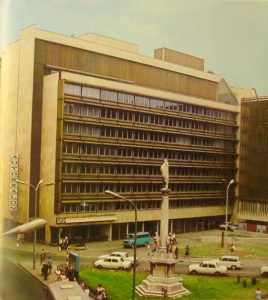National Technical Development Committee
Supporting research and development in the technical field, preparing, discussing and publishing methodological studies to support domestic industry and technical development, and representing Hungary in international technical and scientific relations.
The task of the Commission was to prepare analytical studies and economic development concepts with an international outlook, to represent technical development internationally, and to support certain products and technologies.
Main areas: agriculture, mechanical engineering, metallurgy, pharmaceuticals, energy, computer technology, healthcare, light industry.
OMFB staff prepared and managed the Central Computer Development Program (SzKFP) and the Central Computerization Program,
Infocommunication Technologies and Applications (IKTA) application system.
Its activity was also to provide financial support for R&D activities based on specific applications.
- Árpád Kiss, founding president of the OMFB 1962-1970
- János Sebestyén, founding vice president 1962-
- György Ostrovsky, Vice President 1964-1967
- Miklós Ajtai, president 1970-1978
- Lénárd Pál, president 1978-1980 then 1984-85
- Gyula Szekér, president 1980-1984
- Pál Tétényi, president 1985-1989
- Ernő Pungor, President, Minister 1990-1994
- István Bihari, president 1994- 1998
- Lajos Nyiri, managing director 1998
- Ádám Török, President, Secretary of State 1999-2000
- Imre Jób Baránszky, Head of Department
- István Bernáth, Head of Department
- Tamás Boromisza, Head of Department
- Sandor Bottka, Vice President
- Frigyes Geleji, head of the light industry department, then vice president
- Edit Jávorka, consultant
- László Pál, senior lecturer since 1969, head of department since 1980, head of group since 1985
- Ferenc Pikler, consultant
- Rózsa Sánta, consultant
- Károly Stuka, advisor
- Sándor Szepessi, consultant
- Judit Talyigas, consultant
- Rezső Tarján, presidential advisor
- Béla Zentai, founder, head of the automation and computer technology department, 1962-1980
- István Kiss, Director of the Systems Analysis Institute (REI) since 1978
The OMFB's activity was to support R&D projects through tenders, so among other things, the following were prepared with the help of its financial support:
Development of Proper 16 personal computers (SZKI)
ELLA – electronic mail system (MTA SZTAKI)
HBONE – Development of a TCP/IP based backbone network in Hungary (MTA SZTAKI)
Creation of the Hungarian Electronic Library (OSZK-MTA SZTAKI)
GENESYS framework development (ACCOUNTING)
Ikarus factory robotization experiment (Ikarus)
Information Infrastructure Development – I2F for short – Program (within the framework of the development plan of MTA and OMFB, MTA SZTAKI)
For the organization of ICTA, see From idea to application.
The OMFB was abolished by the government in 1999 and integrated into the Ministry of Education in 2000.
Termination : Pursuant to Act XC of 2003 on the Research and Technological Innovation Fund[5], the OMFB is replaced by the Research and Technological Innovation Council.
Experts contributing to the establishment of the Institute: János Sebestyén (vice president at the time of its founding, later presidential advisor), Árpád Kiss (president at the time of its founding)
The Computer Import Committee, led by János Sebestyén, operated within the OMFB, which approved or rejected applications for the import of machines and components during its monthly meetings, thus having a significant impact on the development of the domestic computer industry.
OMFB has contributed to the development of computer software and hardware, the creation of unique applications, the dissemination of results, and the foundation of computer science education in schools with numerous studies and research support.
The Hungarian Academy of Sciences (MTA SZTAKI) was established in 1964 with the support of the Hungarian Academy of Sciences (OMFB).
OMFB Systems Analysis Office (REI) was founded in 1978.
NIIF was established with the support of OMFB.
In 1961, the OMFB also took over the OMIKK (National Technical Library and Documentation Center) and Section 30 of Decree 17/1976 of the Ministry of Culture states that “the supervision of the professional information activities of libraries shall be carried out by the Minister of Culture together with the President of the National Technical Development Committee”.
The successful operation of the OMFB resulted in, among other things, the advancement of automation and computer technology. The SZKFP (Central Computer Development Program) was formulated here to support computer technology, which, among other things, enabled the purchase of Western licenses and the purchase of computers for certain companies from centralized development funds. János Sebestyén (first vice-president for about 30 years) led the Hungarian side in the Central Computer Technology Committee from 1969, the aim of which was cooperation with the European Economic Community. He was a leading figure in the rejection of the Sofia principle (the software was expensive, and Hungary had a surplus in foreign trade). The success of the office was made possible by the fact that a small number of its employees were already experienced professionals in industrial life (regardless of their political background), and about 2,000-3,000 experts were involved in the work of the Office. The Interministerial Committee – as the domestic coordinating organization of international ESZR cooperation – founded the Computer Technology Coordination Institute /SZKI/ under the supervision of the President of the OMFB.
- OMFB presents itself at the ITF event 2012.
- The OMFB - lessons learned
- OMFB commemorative event, László Kutor, ITF president - welcome speech
- OMFB, the cradle of domestic computer technology
- The OMFB - in the nineties
- History of OMFB office building
- OMFB Systems Analysis Office (REI)
- From idea to application
Created: 2016.05.29. 14:19
Last modified: 2024.05.16. 15:11

